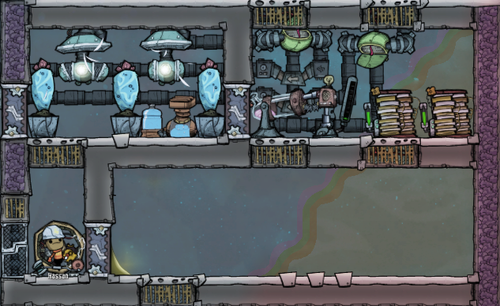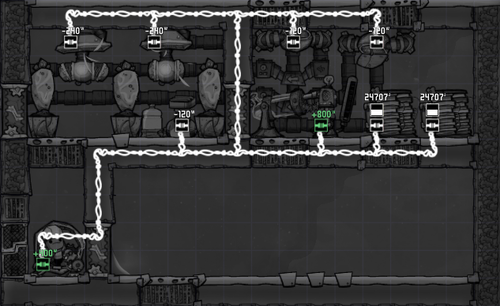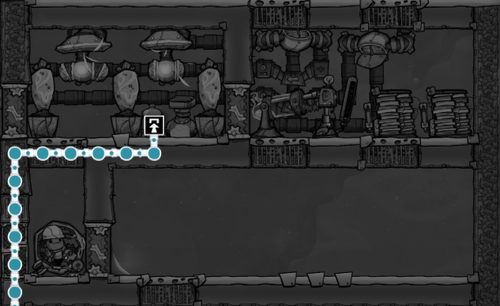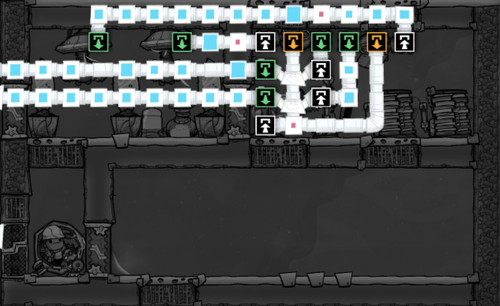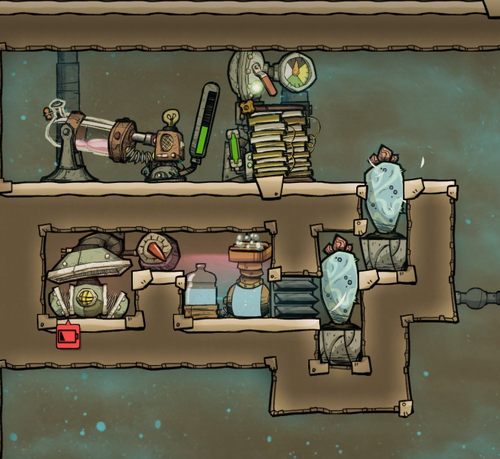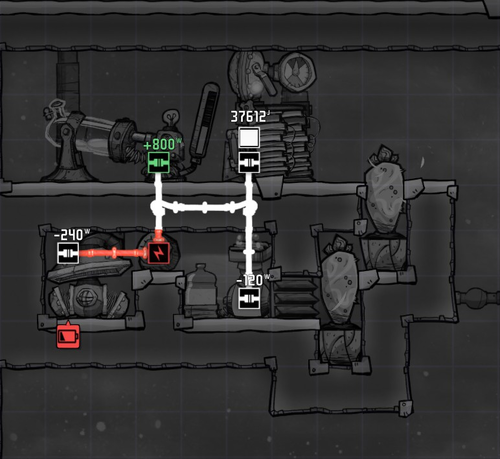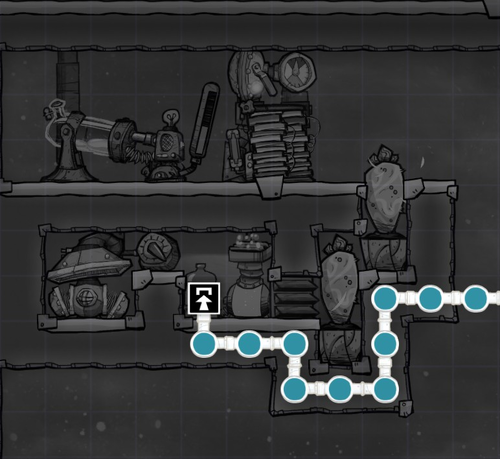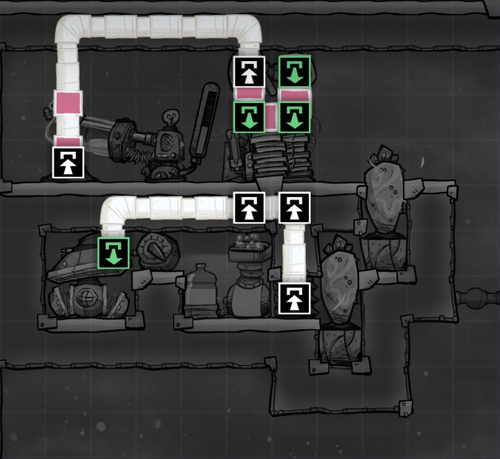Guide/Oxygen
Summary
This Guide is intended to keep your Duplicants from suffocating. It will compare different ways of providing Oxygen to your colony. It will also look into handling CO2 gas resulting from breathing and some structure waste products.
Good to know
- A Duplicant consumes roughly 100 g Oxygen per second.
- Duplicants with Mouth Breather trait require double the oxygen, 200 g/s.
- Duplicants with Diver's Lungs trait require 25 g per second less, 75 g/s.
The Beginning
When your Duplicants appear in your colony on Cycle 1 they can only breathe what is provided, which is mainly a small supply of Oxylite in the Dirt Biome, where you start. It will be exhausted within just a few cycles and there is no way you can rely on it as a permanent solution. But no worries, you can build an Oxygen Diffuser right away and you can research a few additional structures that will replenish your oxygen more effectively. Get your Research Station up and running!
Oxygen Production
Converting Algae to Oxygen
Oxygen Diffuser
The quickest solution is the Oxygen Diffuser, which converts Algae and Power into Oxygen (and heat). One of those theoretically can support up to 6 Duplicants, but because the oxygen doesn't flow away easily it will run into over-pressure quickly and stops working temporarily. In most cases, one Diffuser for every three Duplicants seems to be a good choice.
Pros
- Quick production and delivery.
- Your precious Water is not required for this; all it needs is a Duplicant running a Manual Generator and a Duplicant refilling the Diffuser with Algae.
Cons
- Needs electrical power and produces heat.
- Algae is not an unlimited resource (until you do the Puft + Morb combo). However, you can find pockets of it in the Toxic and Slime Biomes if you send out expeditions.
- 550 g Algae becomes only 500 g Oxygen.
Algae Terrarium
Algae Terrariums produce Oxygen from Algae and Water. Each one produces Oxygen with a rate of 40 g/s - or 44 if under light. You need at least three for each Duplicant (5 per 2 Duplicants) if you want to rely on them as an Oxygen source.
Pros
- Consumes no power and creates no heat.
- 30 g Algae becomes 40 g or 44 g Oxygen per second. More efficient than the Oxygen Diffuser.
- The water it ultimately requires is only 9.666 g per second. Making it also more efficient than the Electrolyzer.
- Oxygen Diffuser and Electrolyzer would together have produced less. 27.2 g + 8.6 g = 35.8 g
Cons
- Needs more instances of it per Duplicant, which comes with more Delivery jobs, unless supplying it with water by flooding their floor will save time but make feet wet.
- Creates large amounts of polluted water and needs emptying labour, which cannot be automated.
- Unlike the Oxygen Diffuser, the Terrarium will continue to produce oxygen no matter the surrounding gas pressure, which if left unchecked will pop your Duplicants' eardrums, causing them stress.
Shortage of Algae
Algae is one of the rare resources, but it can be refined from Slime using an Algae Distiller. This process produces Polluted Water as waste and handling slime involves having to deal with Polluted Oxygen. The Algae Distiller has an output of 200 g/s of Algae, which means under optimal conditions you would need 2.25 Algae Distillers to satisfy the needs of one Diffuser.
Converting Water to Oxygen
Electrolyzer
This one requires multiple research items - You need to gain the Electrolyzer for the process, but to supply it with Water you need to have at minimum Liquid Pipes and Liquid Pump researched, and to move the resulting gases to where you need them you need a Gas Pump, Gas Pipes and Gas Vents. You will have to cope with Hydrogen gas as well, that needs to be kept from spreading through your base. The best option for now is to burn it in a Hydrogen Generator, which requires further research and thoughts on separating the gases. But it gives you back some energy that is required for the electrolysis process, the pumps and Gas Filters.
One Electrolyzer provides 888 g/s of Oxygen per second under optimal conditions. That is enough for up to 8 Duplicants if you have a steady supply of Water and Power, and the Gas is moved quickly enough away from the Electrolyzer (it will stop when the gas pressure around it is too high).
Pros
- You need fewer Electrolyzers per Duplicant.
- Duplicants do not need to manually deliver anything to the Electrolyzer.
- From the beginning there should be enough water to keep your base running for about 100 cycles - then you need to find other ways of providing water.
- The hydrogen an electrolyzer produces can be used to generate power using a hydrogen generator.
Cons
- You need to build pipelines to provide Water, and you need to move the gases away quickly to run at high efficiency. One Electrolyzer produces enough gas to keep two gas pumps busy.
- You need to separate the Hydrogen from the Oxygen, since Hydrogen is an unbreathable gas. It has its uses, but freely floating through your colony is not one of them.
Shortage of Water
Water Sieve
This is one of the obstacles to tackle roughly when you hit cycle 100, because Water is used for Research, Food and Hygiene as well. After a while you will have to convert Polluted Water into Water again. You can use the Water Sieve for this - the output of one Water Sieve is enough to feed five Electrolyzers. But it requires manual supply of Sand|Filtration Medium, removal of Polluted Dirt which usually requires two Compost places per Water Sieve, and, of course, power. If this sounds like it'll keep your Duplicants busy, it will.
Water geysers
One of the better ways to produce water is using a water geyser which produces a lot of water for free, which you can then use for plants, hygiene, oxygen diffusers, ...
With a water geyser you will need to cool down the water first because when it comes out of the geyser it wil be too hot to use for most things.
A salt water geyser will require you to cool the water down but also to turn the salt water into fresh clean water, this can be done using a desalinator.
Another (better) option is finding a cool salt slush geyser, this water can first be used to cool other things down and then, using a desalinator, turned into normal water. It is important that you warm it up first because if you run it straight into a desalinator your liquid pipes will break due to the water freezing.
You will need a backup of water when the geyser goes dormant.
Steam Geyser
Another option is to consume water from the Steam Geyser, if you find one. It is an infinite source of Water - but it is hot. Moving hot water into your base will heat it up, so you need insulated pipes for that; electrolyzing hot water results in hot gases, so you will need to cool either the water or the gas. For gas cooling you can apply Thermo regulators, for cooling down Liquids you need to design yourself a coolant system, and at the current state of the game it takes a long time to cool down liquids. A quicker way, but not a permanent solution is to drop Ice and Snow into your hot water.
Distillation
If you do not have access to a Steam Geyser, you could develop a water distillery. If you heat Polluted Water to its boiling temperature, it becomes Steam which condenses back to Water- Hot Water, to be exact, so everything said about Steam Geyser above is valid for this solution too.
Converting Polluted Oxygen to Oxygen
Polluted Oxygen is also breathable gas but at risk of Slimelung infection.
Deodorizer
Deodorizer convert partial Polluted Oxygen to Oxygen at cost of Filtration Medium, then produce Clay. Build a cluster of deodorizers to speed up conversion.
Source of Polluted Oxygen
Geysers
You need to deal with extremely hot gas from Hot Polluted Oxygen Vent or gas full of Slimelung from Infectious Polluted Oxygen Vent.
Polluted Water
When the air pressure is less than 1.8 kg, a pool of Polluted Water will emit polluted oxygen slowly from the surface. Using Airflow Tile to build a liquid tank for Polluted Water will provide maximum surface area to maximize Polluted Oxygen production. Bottles of Polluted Water emit Polluted Oxygen at a high rate as well. A large amount of Polluted Water bottles can supply your colony lots of Oxygen and Clay. Ways to get bottles if there is already a large pool:
- Use Pitcher Pump and an unreachable Bottle Emptier.
- Pump water to a Liquid Reservoir and deconstruct it.
- A Plumber can empty pipes.
- Mop Polluted Water on the floor.
Pros
- Little power is needed. Usually a Gas Pump is needed to transfer Polluted Oxygen from the source.
- Provides Clay through a Deodorizer. Clay is required to produce Ceramic, a useful insulator.
Cons
- The conversion does not eliminate Slimelung. Duplicants might become infected before Slimelung dies in Oxygen.
Solution Comparison
The following table compares energy needs per kg Oxygen for each solution. To properly compare the processes we calculate required Energy and Heat per needed Time for the generation of 1,000 g of Oxygen (equivalent of 10 Duplicants breathing for 1 second, or one breathing for 10 seconds), ignoring Delivery time delays, optimized on each structure capacity.
| Path to Oxygen | Required Buildings | Required Energy [J] | Required Time [s] | Required Resources [kg] | Waste Products [kg] | Heat Energy [kDTU] | O2 g/s | Power per g O2 | ||||
|---|---|---|---|---|---|---|---|---|---|---|---|---|
| From | To | Note | Each | Sum | Each | Sum | ||||||
 Oxygen Diffuser Oxygen Diffuser
|
1 |
240 | 2 | - | 3 | 500 | 0.24 | |||||
 Algae Terrarium Algae Terrarium
|
no light | 1 |
- | 25 | 0+ | 40 | 0 | |||||
| with light | 1 |
- | 113.64 | 22.73 | - | 11.36+ | 44 | 0.11 | ||||
| 1 |
113.64 | 11.36+ | ||||||||||
 Oxygen Diffuser Oxygen Diffuser
|
11 |
660 | 900 | 0.5 | 8.25 | 11.25 | 2000 | 0.9 | ||||
| 4 |
40 | 3 | ||||||||||
 Algae Terrarium Algae Terrarium
|
no light | 3 |
450 | 450 | 1.25 | 5.625+ | 5.625+ | 800 | 0.45 | |||
| 20 |
- | - | ||||||||||
| with light | 3 |
409.1 | 420.5 | 1.136 | 0.568 | 5.682+ | 880 | 0.421 | ||||
| 20 |
- | - | ||||||||||
| 1 |
11.4 | 5.114+ | ||||||||||
 Electrolyzer Electrolyzer
|
pure | 1 |
27.0 | 837.8 | 0.113 | 0.225 | 1.633+ | 8,880 | 0.838 | |||
| 10 |
135.1 | 1.408+ | ||||||||||
| 20 |
540.5 | - | ||||||||||
| 10 |
135.1 | - | ||||||||||
| mixed | 1 |
27.0 | 851.4+ | 0.113+ | Unused Liquid |
0.225 | 2.083+ | ~8,880 | 0.851+ | |||
| 1 |
13.5 | 0.450 | ||||||||||
| 10 |
135.1 | 1.408+ | ||||||||||
| 20 |
540.5 | - | ||||||||||
| 10 |
135.1 | - | ||||||||||
| Filtration | 1 |
27.0 | 864.8 | 0.113 | 0.225 | 2.534+ | 8,880 | 0.865 | ||||
| 2 |
27.0 | 0.901 | ||||||||||
| 10 |
135.1 | 1.408+ | ||||||||||
| 20 |
540.5 | - | ||||||||||
| 10 |
135.1 | - | ||||||||||
 Electrolyzer Electrolyzer
|
dropping Algae | 25 |
337.8 | 1175.7 | 0.113 | 4.223 | 6.532+ | 8,880 | 1.176 | |||
| 2 |
27.0 | 0.901 | ||||||||||
| 10 |
135.1 | 1.408+ | ||||||||||
| 20 |
540.5 | - | ||||||||||
| 10 |
135.1 | - | ||||||||||
| consuming Algae | 275 |
233.5 | 858.9 | 6.77×10-3 | 2.793 | 5.336+ | 147,680 | 0.859 | ||||
| 22 |
17.9 | 0.596 | ||||||||||
| 110 |
89.4 | 0.931+ | ||||||||||
| 220 |
357.5 | - | ||||||||||
| 110 |
89.4 | - | ||||||||||
| 100 |
81.3 | 1.016+ | ||||||||||
- ↑ A single Lamp can support up to 18 Algae Terrarium, while Ceiling Light can support up to 21 Algae Terrarium.
Carbon Dioxide Removal
Carbon Dioxide (CO2) is a waste product of Duplicants breathing, from burning Coal in a Coal Generator, or burning Natural Gas in a Natural Gas Generator. It is an unbreathable gas and so makes your Duplicants hold their breath, stressing them and interrupting their sleep (which stresses them even more) and work. Luckily, because of its weight, it has a tendency to drop to the bottom corners of your colony and forms pockets of unbreathable gas there. At the beginning of the game you will be fine as long as you have a low spot in your colony where Duplicants rarely have to go.
Duplicants exhale 2g/s of CO2 which is very little, compared to the 100 g/s of Oxygen they inhale.
Pumping it into space
The best way to get rid of unwanted CO2 is by pumping it into space, whilst not being accessible in the early game it is the easiest way to get rid of CO2 without using to much power, water or other recourses. By placing a gas vent onto a vacuum tile the CO2 will disappear into space. TIP: Do block of the vent with vacuum otherwise other gases, including oxygen, in the area might get sucked in also. It is also a good a good idea to hook the gas pump up to an atmo sensor and/or gas element sensor so it is not wasting power or pumping other gases into space.
Algae Terrarium
When your CO2 pockets start to become worryingly large, you might start to control them with Algae Terraria. Each one consumes 1/3 g/s of CO2, so you'll need 6 of them for each Duplicant in your colony. They produce Oxygen, too, with a rate of 40 g/s - or 44 if under light.
It needs to be regularly, manually supplied with Algae and Water. If submerged in water, it can take the water from its surroundings instead. Considering the number of them required per Duplicant, and all the Delivery jobs required by them, they are not a good solution for a growing colony.
Pros
- Quickly available
- No power wires or water pipes required
Cons
- Dependent on Water and Algae, which will become scarce.
- Many instances required, resulting in lots of Delivery jobs.
Carbon Skimmer
Once the CO2 pockets turn into CO2 caverns and clog the lower areas of the base, it's worth investing in the Carbon Skimmer. Just one should be enough for a longer while. It consumes 300 g of Carbon Dioxide per second, which is enough for 150 Duplicants - under the idealistic assumption that the colony does not burn Coal or Natural Gas in a Generator.
Pros
- Doesn't require any maintenance (other than repairs in case of accidents)
- Doesn't require a gas pump nor a filter
- Just one instance removes enough CO2 to satisfy the needs of any feasible colony that doesn't use gas generators (those that do rely on gas generators will need more than one)
Cons
- Pollutes water
- Has non-negligible electricity cost
- Produces heat at a +1 kDTU/s rate
Slickster
A captured Slickster will consume up to 250 g/s of CO2 and turn it into Crude Oil.
Pros
- Produces Crude Oil
- No maintenance or resource usage
Cons
- The Slickster will die if its body temperature drops below ~35 °C
Gas-To-Liquids
Carbon Dioxide can be cooled down to its Dew Point temperature (-48.1 °C) to become a Liquid. Why should you do that? Mostly because the limits of Pressure gas can have to let a Gas Vent release its content. The game restricts it at 1800 g of any gas in its tile. This can be gamed (see next section) but it is more of a challenge to accept it and work around it. 1800 g of a Gas is not much. The same tile could hold hundreds of kg of a Liquid. If you create a Container for Liquification with an inner size of 10x10 tiles, this could hold about 60,000 kg of CO2 (you can store 600 kg Liquid Carbon Dioxide per tile). Probably more than you will ever produce: One Coal plant produces 20 g/s of Carbon dioxide, and if you continuously run 10 of them you would produce one kg of it every 5 seconds, or 120 kg per cycle, this would reach for 500 cycles.
To cool down the gas you need something cooler than itself that transfers the heat away. The mostly used solution is to pump very cold Hydrogen gas through a loop of gas pipes made of a material with good heat conductivity through the gas container you want to cool down. Hydrogen is best choice due to its low Dew Point (-252.2 °C). To cool the Hydrogen down you can use Thermo Regulator. Using Wheezewort is not recommended as it does provide very little cooling effect - it is mainly a decision of what you have more of, time or energy. The Thermo Regulator cools down Gas passing through it by 14 °C but it heats up doing so. Cooling it down with a Hydrofan is likely required. It is recommended to have a little container of Hydrogen gas in your "Freezer" to switch off the Thermo Regulator in the loop if the reservoirs temperature drops below -220 °C - it would be annoying to get Hydrogen gas become liquid in the gas pipes and cause material damage.
Pros
- You can boast on the Klei User Forum about your clever design
Cons
- Quite some power required to drive all the pumps, filters, thermo regulators involved
- You need to find a solution what to do with the heat emanating from the Thermo Regulators. (Maybe steam production in a Water distillery?)
Compression
This actually a gaming trick. To circumvent the fact that a Gas Vent only vents when its tile has a pressure of less than 1800 g, the gas needs to be replaced quickly. And having some drops of liquid on its tile helps on this. Liquid present, Gas gets pushed to a neighbor tile immediately, ignoring existing pressure. The Tile under the Gas Vent becomes free again and can vent. The pressure in such a chamber can be risen almost indefinitely.
Pros
- No power required for storing the gas away
Cons
- Kind of cheating. (Note: The biggest drawback to relying on an exploit for part of your build, is it's inevitable loss of functionality once the developers discover and do away with it. As such, it's best not to rely on any exploit long term.)
Pump to outer space
Available since the Cosmic Upgrade, one can pump any unwanted liquids or gases to outer space. Keep digging upward until you find some regions where the info says it's exposed to space. Build Mechanized Airlock or Manual Airlock before going to this region to prevent accidentally draining your precious gas. Simply pipe unwanted gas here with a Gas Vent as output. The space very efficiently destroys gas. One can even build it without any complicated equipment like Exosuit and just let them holding breath for a little while, since building some pipes and vent is quick.
Pros
- Require little / none energy to build.
- Require little technology.
- Works for other unwanted elements, e.g. Chlorine.
Cons
- Took some time to dig upward (if it counts as a Con)
Example Builds
| Schematic | Notes | |
|---|---|---|
|
This design uses gas filters
Notes:
| |
|
This design uses a mechanical filter to separate out hydrogen. The atmo switch is set to above 600 g. |

